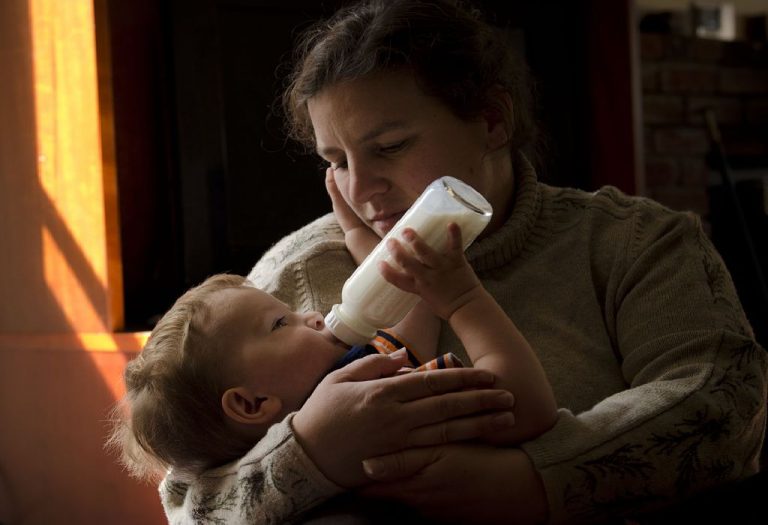Baby Feeding – What to Feed & How Much to Feed

Despite the joys that motherhood offers, many aspects can leave you baffled. ”How much to feed a baby?” ”When to feed a baby?” ”Is it okay to wake up a sleeping baby to feed?” – these are some common questions among parents, especially newbies. Though it’s said that there is no such thing as overfeeding a baby, there is indeed a thin line between underfeeding and overfeeding your child. Baby feeding need not always be strict with the numbers; it comes down to learning about the right proportions at the right age.
The good news is that we have it all covered in our baby feeding schedule by age. From newborn baby feeding to feeding tips to knowing where to draw the line if you are indeed overfeeding or underfeeding your little princess or prince, read on to find out how to do it right.
Baby Feeding for the First Year
Among the many tasks that you will have to take on as a mother, the growth of your child into a strong and happy baby is probably the foremost on your agenda. Food that makes your baby healthier, stronger and happier is something to fuss about and let nobody tell you otherwise.
Nevertheless, what to feed as well and when to feed should be treated with the utmost importance, too. This is why we have charted out a wise course of action for infant feeding, which you can follow till your baby turns one. This baby feeding guide month by month will help you provide your baby with the right nutrition at the right time.
Age – 0 to 4 Months-Old Baby
For babies up to 4 months of age, there are two: breastfeeding and formula feeding. While the jury is out on which one is a better alternative, let’s cover the timings of each along with how much is required for growth.
- What to Feed: Either breastmilk or formula.
- How Much to Feed: For breastfed infants, 8 to 10 helpings or an on-demand module of feeding per day. For formula-fed kids, 6 to 8 helpings per day.
- Feeding Tips: Make sure that your kids are fed every 2-3 hours (1). Formula-fed kids are advised to be fed every 3-4 hours. The WHO and AAP recommend exclusive breastfeeding for babies till 6 months of age (2) (3).
Mothers who choose to breastfeed should be prepared for an on-demand feeding approach, especially during the first couple of months (4). Though there’s no hard and fast rule, it is seen that babies who are breastfed need at least 8 to 10 helpings every day in the first few weeks to sate their appetite (5). Also, remember to feed your precious ones every couple of hours in order to keep them from being deprived of nutrition. Don’t push the feeding to more than three hours in a day.
For mothers who have decided to go by formula, a word of caution would be that you are more at risk of overfeeding your baby than mothers choosing baby milk feeding. Formula feeding is slightly more difficult to digest than breastmilk, so make sure that you don’t go beyond feeding your baby 6 to 8 times per day. Also, try to restrict mealtimes to every 3 to 4 hours each day.
However, as your baby grows older, he sleeps longer. In fact, by the time the third or fourth month arrives, it’s seen that mealtimes will automatically come down, as breastfed infants will need only 6 to 8 servings of breastmilk. Meanwhile, formula-fed infants will require only 5 to 6 servings a day, typically spread over 4 to 5 hours.
Age – 4 to 6 Months-Old Baby
This period of your baby’s existence can prove to be a bit different. In fact, for many, it could prove to be tricky as mothers would need to make a safe call on whether to introduce solid foods into the infant’s diet or not.
- What to Feed: Breastmilk and gradual transition to simple solid foods.
- How Much to Feed: Significant decrease in breastmilk or formula, maybe 4-5 times a day.
- Feeding Tips: The introduction of solid foods will be quite the transition, especially if your kid is fussy with food. Start with cereal and move on to strained fruits and vegetables.
For mothers who want to stick to breastfeeding, it’s advisable not to feed the baby more than 6 times a day. As mentioned earlier, breastfeeding is more of an on-demand meal, so the number of servings for each infant will vary. As far as formula-fed babies are concerned, it’s advised not to serve food more than 5 times a day.
If you are foraying into solid foods for your baby, look for signs that your baby is indeed ready for the same. For starters, your sweetie should start taking an interest in food and show some proper weight gain in order for them to start on solid foods. Other signs include sitting in a high chair and holding the heads up high. It is important to note that many international organisations, such as the American Academy of Family Physicians recommend the introduction of solid food around 6 months (6) (7). So, only if your baby seems ready for having solids, you should introduce such foods to them
As far as solid food choices are concerned, begin with grains. Oatmeal and iron-fortified rice cereal are excellent choices to start with. Mixing in a spoon of dry cereal with your usual formula or breastmilk to feed your baby is a good way to go about it. You can start with one to two tablespoons of pureed twice daily Don’t try mixing more than 5 to 6 teaspoons of either formula or breastmilk, as it will be very runny initially. Over time, thicken the consistency by mixing less of the milk or the formula and more of the cereal to see how your baby reacts to it.
As the weeks progress, introduce one new kind of food to your baby every day. After cereal, try to introduce vegetables and fruits, preferably strained to see how your baby responds to them. Be cautious not to push too far, and look out if your baby seems to be allergic to something.
Age – 6 to 8 Months Old Baby
If your baby has responded well to solid foods, then ensure that your baby continues to get the taste of a variety of solid foods, either pureed or soft-cooked and typically bland. Pureed vegetables and fruits can steadily be given in order to keep up with the baby’s growing bodily needs. Team that up with more cereal servings per day, say up to 3 times a day for better effect.
- What to Feed: Moving on from simple cereals and strained fruits and vegetables to pureed and soft-cooked foods.
- How Much to Feed: Striking a balance between feeding breastmilk/ formula and solid foods.
- Feeding Tips: Try one solid food at a time.
Nevertheless, mothers should also try to keep breastmilk or formula in their diets, though in lesser amounts. For babies being breastfed, it’s advisable to restrict feedings to not more than 5 or 6 feedings a day. Since the intake of solid foods goes up, the number of feedings will go down. For formula-fed babies, a couple of feedings per day would be sufficient for the same reasons cited above.
Age – 8 to 10 Months-Old Baby
By the 8th month of infant feeding. your baby’s diet should include foods that have more combinations and textures. Juice, for one thing, can now be safely given to babies, restricting the amount to not more than a small cup. Fresh juices made out of pears, while grapes or apples are excellent choices for both the nutritional values and taste factors.
- What to Feed: Simple solid foods and foods with combination and textures such as juices.
- How Much to Feed: For formula-fed kids, one serving. For breastmilk-fed infants, 2-3 servings are needed.
- Feeding Tips: If your baby is still dependent on breastmilk/ formula, you might want to be a little pushy with solid foods, as your child should already be teething.
Since the intake of solid foods will only keep increasing, mothers who have breastfed or chosen formula so far can safely decrease the number of servings they offer their infants. Formula-fed kids need only one serving per day, while breastmilk can be decreased up to 2 or 3 servings per day.
Age – 10 to 12 Months-Old Baby
And finally, the last crucial months before your kid turns the big 1! As the kid increasingly transitions to solid foods, the proud mother can happily look for signs that ensure that their baby is growing older.
For one, your baby will suddenly feel the need to put whatever they find in their grasp into their mouths. As dangerous as it sounds, it sure is a positive sign that your baby is craving for varied foods now. Your baby will also make cute little chewing gestures, try and pick up whatever they find around them and turn objects around their hands. All such signs and more are reminders that your baby is growing up.
- What to Feed: Besides what has been covered above, let’s take a look at what you can feed your infants in the last couple of months till 12 months. One of the best things to offer them would be finger foods. Pieces of soft fruits such as bananas are usually very popular with kids of that age. Since your baby will also be teething, make sure that foods such as meat and proteins are pureed or mixed in a way that’s easily chewable. Refrain from giving egg whites right away. Stick to egg yolks, cooked pasta, and funny-shaped cereals that are low in sugar. Continue giving enough portions, which are cut up into small pieces that are easy to chew and digest.
- How Much to Feed Per Day: As covered earlier, the process of feeding your baby depends upon what period of growth we are looking at. For one, infants between ages 9 to 12 will still need to be breastfed or formula-fed, but the servings must go down quite a bit. As babies continue to rely on more solid foods, it will be seen that very soon, mashed beans and milk products such as cheese and yoghurt will be preferred. For age groups before that, the comprehensive breakdown above can be easily followed to make sure that your kids are neither going hungry nor overfed.
- Feeding Tips: The most important thing to remember is that your baby, while growing up, will always need food. However, the question will always remain: how much and how many times a day? In so many ways, mealtimes for kids are easier when they stick to breastmilk or formula.
The real task arrives when babies transition to solid foods. Besides allergies to certain food groups, small mistakes on your part, such as undercooked protein or vegetables or complex foods, can give rise to choking or indigestion. Also, remember that your baby will not respond well to every new food. Make sure to try after a gap of a few days to see how it goes.
Things to Watch Out for to Ensure That You Are Not Underfeeding or Overfeeding Your Baby
While it’s commonly believed that there is no overfeeding a baby, chances are that you can just as easily underfeed or overfeed your baby. Read the following to know more.
1. Signs That Your Baby Wants to Eat More
Your baby will definitely cry and remain cranky. Signs such as restlessness, keeping the mouth open, and sucking on things, such as fingers and fists, are all signs that your baby wants to eat more.
2. Signs That Your Baby May Have Enough Food
As a natural instinct, your baby will close its mouth, turn away its head, and plain reject your attempts to feed them when they have had enough to eat.
FAQs
1. When should I start my baby on solid foods?
Solids or semi-solids should be introduced once your child attains six months of age. Look for your baby’s readiness, such as ability to sit in a high chair with a good head control, reaching for food when they see it, learning swallowing techniques, and the right age (8).
2. Which solid food should I give my baby first?
Pureed fruits, veggies, or meat and baby cereal are popular choices among solid foods for babies. You can ask your paediatrician for the appropriate meal plan for your 6 months+ baby, and they will recommend the diet according to the baby’s progress. Later, by 8-10 months of age, you can introduce mashed foods like mashed banana or pear, steamed veggies, scrambled eggs, and well-cooked, chopped pasta (9).
Some days, babies feed less, while on some days, their hunger cues never stop. So, it is possible to wonder whether your baby is feeding enough or getting enough nutrition for their healthy growth and development. As long as your baby is pooping, peeing, and doing all the regular activities normally in their active state, looks satisfied after every feed, and is not seeming lethargic, they are getting enough (10).
5. What are the important feeding tips for babies under the age of 1 year?
Babies under the age of 1 should not be given honey, as it is contaminated with Clostridium botulinum bacteria (also found in soil), which can be detrimental to a baby’s life. It causes infant botulism (11).
6. What food items should be avoided giving to babies?
Salt, sugar, honey, water, saturated fate, like biscuits and cakes, whole nuts and peanuts, mould-ripened soft cheeses, cheese made from unpasteurised milk, and raw eggs, meat, fish, shellfish, or chicken should not be given to babies and young children (12).
Also Read:
Finger Food Recipes for Baby
5 Healthy Vegetable Purees for Baby
Best Fruit Purees for Babies
Was This Article Helpful?
Parenting is a huge responsibility, for you as a caregiver, but also for us as a parenting content platform. We understand that and take our responsibility of creating credible content seriously. FirstCry Parenting articles are written and published only after extensive research using factually sound references to deliver quality content that is accurate, validated by experts, and completely reliable. To understand how we go about creating content that is credible, read our editorial policy here.
1. Johns Hopkins Medicine – Feeding Guide for the First Year
3. American Academy of Pediatrics – Breastfeeding: AAP Policy Explained
5. La Leche League International – Frequency of Feeding
6. AAFP – Breastfeeding, Family Physicians Supporting (Position Paper)
7. Frontiers in Pediatrics – First Bites—Why, When, and What Solid Foods to Feed Infants
8. American Academy of Pediatrics – Starting Solid Foods
9. American Academy of Pediatrics – Sample Menu for a Baby 8 to 12 Months Old
10. Nemours KidsHealth – Formula Feeding FAQs: How Much and How Often
11. Nemours KidsHealth – Infant Botulism
12. NHS – Foods to avoid giving babies and young children
























